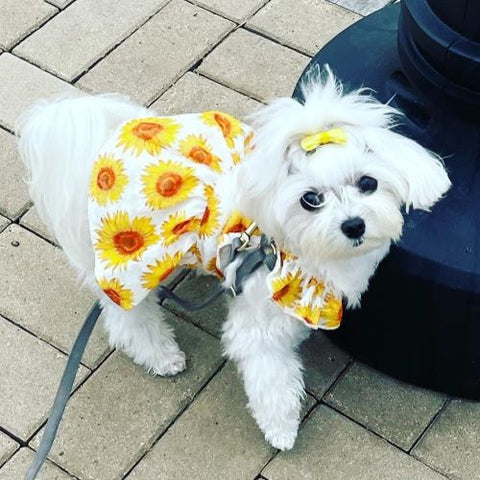Spring Free Spring: una guía del dueño de un perro para conquistar alergias
A medida que se acerca la primavera, empezamos a ver más sol, flores y vegetación. Pero esta época del año también puede traer alergias a nuestros perros. El polen, el moho y el polvo pueden causarles picazón e incomodidad. Es importante preparar a tu perro para estas alergias para que pueda disfrutar de la primavera como nosotros. Aquí te mostramos cómo ayudar a tu perro a lidiar con las alergias durante la primavera y a que se sienta bien.

Instagram: cavapruechon
Entendiendo las alergias primaverales en los perros
Los perros también pueden sufrir alergias estacionales, al igual que las personas. El síntoma llamado dermatitis atópica canina ocurre cuando el sistema inmunitario de un perro reacciona demasiado a las cosas que lo rodean. La primavera puede ser difícil debido a todo el polen de los árboles y el césped, el moho e incluso las pulgas que disfrutan del clima cálido. Pero a diferencia de los humanos que pueden tener congestión nasal o estornudos, los perros suelen tener problemas de piel cuando lidian con las alergias. se manifiestan cuando el sistema inmunitario de un perro reacciona de forma exagerada a los alérgenos ambientales. Estos alérgenos, presentes predominantemente durante la primavera, incluyen el polen de los árboles, el polen de la hierba, las esporas de moho e incluso las pulgas que se vuelven más activas en temperaturas más cálidas. A diferencia de los humanos que experimentan síntomas respiratorios, los perros generalmente muestran signos de alergias a través de su piel.
Signos de alergias primaverales en los perros
Con la llegada de la primavera, llegan también las alergias que pueden complicarle la vida a tu perro. Conocer los síntomas a los que prestar atención es crucial para anticiparse a cualquier reacción alérgica. A continuación, analizamos con más detalle los signos comunes que tu perro podría presentar si experimenta alergias estacionales:
- Rascado o lamido excesivo: Una de las señales más evidentes es si tu perro empieza a rascarse más de lo habitual o a lamerse zonas específicas sin parar. Este comportamiento puede indicar que algo le está irritando la piel.
- Piel roja e inflamada: Al examinarlo más de cerca, podría encontrar zonas enrojecidas o inflamadas en la piel de su perro, especialmente alrededor de las patas, la panza y las orejas. Estas manchas pueden ser sensibles al tacto e indicar reacciones alérgicas.
 Instagram: ms.mochie
Instagram: ms.mochie
- Estornudos y secreción nasal: Al igual que los humanos, los perros pueden presentar síntomas respiratorios a causa de las alergias. Los estornudos frecuentes y la secreción nasal clara son señales reveladoras de que su perro podría estar reaccionando a alérgenos transportados por el aire. Si desea saber... Cómo limpiar la nariz que moquea de tu perro, lea esta publicación de blog nuestra.
- Ojos llorosos: Las alergias también pueden provocar que los ojos de tu perro lagrimeen más de lo habitual, lo que provoca manchas de lágrimas en su pelaje. Esto puede resultarles incómodo y es una señal de que los alérgenos están afectando sus ojos.
- Infecciones de oído: Los perros con alergias son más propensos a desarrollar infecciones de oído. Si su perro sacude la cabeza con frecuencia o se rasca las orejas, podría ser momento de revisar si tiene una infección, que puede ser un síntoma secundario de alergias.
 Instagram: iggychelseaandme
Instagram: iggychelseaandme
Ser proactivo a la hora de detectar estos síntomas puede marcar una diferencia significativa en el control del bienestar de su perro durante la temporada de alergias.La detección temprana permite tomar medidas para aliviar las molestias antes, evitando que los síntomas empeoren. Recuerda, si tienes dudas sobre la salud de tu perro o si los síntomas persisten a pesar de tus esfuerzos, lo mejor es consultar con un veterinario para obtener asesoramiento profesional y opciones de tratamiento.
Medidas proactivas para las alergias primaverales de su perro
Tomar medidas proactivas puede aliviar significativamente las molestias que tu perro pueda experimentar debido a las alergias primaverales. Aquí te explicamos cómo puedes ayudar:
- Aseo regular: Bañar a tu perro regularmente durante la temporada de alergias puede eliminar los alérgenos acumulados durante el día en su pelaje y piel. Opta por un champú suave e hipoalergénico que no irrite aún más su piel. Además, aumentar la frecuencia del cepillado ayuda no solo a distribuir los aceites naturales de la piel, sino también a eliminar el polen, el polvo y la caspa que se acumulan en su pelaje.
- Medio ambiente limpio: Un ambiente con menos alérgenos puede marcar una gran diferencia en el control de las alergias de su perro. Aspirar regularmente pisos y muebles, especialmente en áreas donde su perro pasa mucho tiempo, puede capturar y eliminar los alérgenos. Los purificadores de aire con filtros HEPA también pueden limpiar el aire de polen y esporas de moho. No olvide lavar la ropa de cama, los juguetes y las fundas de tela de su perro con agua caliente semanalmente para eliminar los ácaros del polvo y los alérgenos acumulados.
 Instagram: rockynycmorkie
Instagram: rockynycmorkie - Apoyo dietético: Enriquecer la dieta de su perro con ácidos grasos omega-3, presentes en el aceite de pescado, puede favorecer la salud de la piel y reducir la inflamación a los alérgenos. Una dieta equilibrada, rica en vitaminas y minerales, fortalece el sistema inmunitario, reduciendo la susceptibilidad de su perro a las alergias. Consulte con su veterinario para obtener recomendaciones sobre suplementos y cambios en la dieta que podrían beneficiar a su perro.
- Visitas al veterinario: Una revisión veterinaria a principios de primavera puede preparar a tu perro para la temporada de alergias. Tu veterinario puede ofrecerte consejos personalizados según el historial de salud y el estado actual de tu perro. También puedes pedirle que te recomiende o recete medicamentos para controlar los síntomas de la alergia. Si es tu primera visita al veterinario, recuerda... guías para visitas veterinarias.
 Instagram: baileythequarendoggo
Instagram: baileythequarendoggo- Pruebas de alergia: Para perros con síntomas de alergia persistentes o graves, las pruebas de alergia pueden ser una herramienta valiosa. Esto puede realizarse mediante análisis de sangre o pruebas cutáneas intradérmicas. Identificar los alérgenos específicos permite implementar estrategias de manejo específicas, como la evitación, la inmunoterapia (vacunas contra la alergia) o ajustes dietéticos específicos.
- Ropa protectora: Vestir a tu perro con ropa protectora, como camisetas o monos ligeros, puede crear una barrera entre su piel y los alérgenos ambientales. Estas prendas ayudan a minimizar el contacto con irritantes durante los paseos o los juegos al aire libre. Elige telas transpirables para garantizar que tu perro esté cómodo y no pase calor.
 Instagram: macandmillie0622
Instagram: macandmillie0622
Disfrutemos la temporada juntos
Con la llegada de la temporada de flores y nuevos comienzos, es fundamental garantizar que su perro disfrute del esplendor primaveral sin la carga de las alergias. Tomar medidas proactivas para abordar las alergias estacionales no solo mejora la comodidad de su perro, sino que también enriquece las experiencias compartidas de esta vibrante época del año. La atención temprana y constante a los síntomas de alergia de su perro es crucial para fomentar su bienestar, permitiéndoles a ambos disfrutar juntos de la alegría de la primavera.

Instagram: daisytheyorkie2020
En resumen, preparar eficazmente a su perro para los desafíos de las alergias primaverales requiere una cuidadosa combinación de observación, medidas preventivas y, cuando sea necesario, atención veterinaria profesional. Al adoptar un enfoque cuidadoso e informado sobre la salud de su perro, allana el camino para una temporada llena de felicidad y salud, asegurando que la primavera siga siendo una época de disfrute para usted y su querida mascota.














